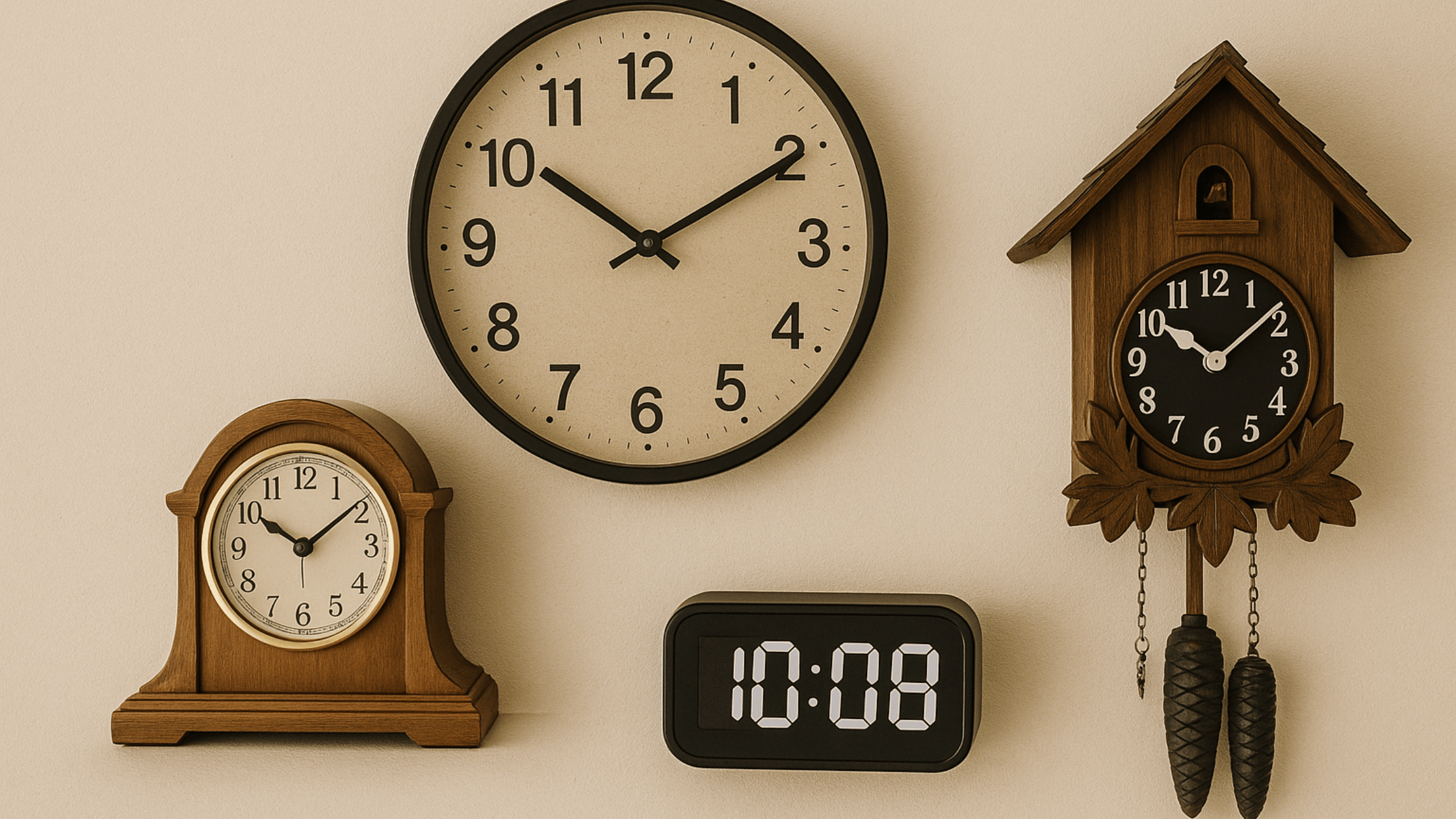The Different Types of Clocks: A Complete Guide
From ancient sundials to sleek modern designs, clocks have been an essential part of human life for centuries. They do more than tell time — they reflect technology, craftsmanship, and even personal style. Whether you’re looking to decorate your home, collect vintage pieces, or simply understand the options available, knowing the different types of clocks will help you make the right choice.
In this guide, we’ll explore the most popular types of clocks, from classic grandfather clocks to minimalist digital clocks. We’ll also share their features, best uses, and styling tips so you can find the perfect timepiece for your needs.
II. 12 Main Types of Clocks
Clocks can be classified by their design, function, and placement. Here are twelve of the most common and decorative types of clocks you’ll encounter.
1. Wall Clocks
Wall clocks are the most popular and versatile type of clock, found in homes, offices, and public spaces. They can range from simple, functional designs to elaborate decorative pieces that serve as focal points in a room.
Best For: Living rooms, kitchens, offices, classrooms.
Popular Styles:
- Modern minimalist wall clocks
- Vintage farmhouse designs
- Oversized statement clocks
Styling Tip: Match the size of your wall clock to the space available — oversized clocks work well on large blank walls, while smaller ones suit compact rooms.
2. Mantel Clocks
Mantel clocks are small, freestanding clocks traditionally placed on fireplace mantels, bookshelves, or sideboards. Known for their elegant designs, they often feature wood casings and intricate details.

Best For: Living rooms, libraries, formal dining rooms.
Popular Styles:
- Classic wooden mantel clocks with Roman numerals
- Art Deco or mid-century modern styles
- Chiming mantel clocks with Westminster chimes
Styling Tip: Pair your mantel clock with framed photos, candles, or vases to create a balanced vignette.
3. Grandfather Clocks
Grandfather clocks — also called longcase clocks — are tall, freestanding timepieces with a pendulum mechanism. They are known for their stately presence and rich wood craftsmanship.

Best For: Entryways, living rooms, and formal halls.
Key Features:
- Height: usually 6 to 8 feet tall
- Mechanical movement with weights and pendulum
- Often features a chiming mechanism
Styling Tip: Position your grandfather clock in a prominent location where it can be appreciated, and avoid overcrowding the space with other tall furniture.
4. Cuckoo Clocks
Cuckoo clocks are decorative mechanical clocks that chime and display a small bird figure that emerges to mark the hour. Originating in Germany’s Black Forest region, they are loved for their charm and intricate carvings.
Best For: Rustic cabins, traditional homes, collectors’ displays.
Popular Designs:
- Traditional chalet-style cuckoo clocks
- Modern interpretations with simplified shapes
- Musical cuckoo clocks with moving figurines
Styling Tip: Hang your cuckoo clock at eye level in a cozy space like a kitchen or living room to enjoy its animation and chimes.
5. Table Clocks
Table clocks are compact timepieces designed to sit on desks, bedside tables, or shelves. They combine portability with style, making them ideal for both decorative and functional use.
Best For: Offices, bedrooms, small living spaces.
Popular Styles:
- Classic brass carriage clocks
- Modern digital LED table clocks
- Rustic wood tabletop designs
Styling Tip: Choose a table clock that complements the surrounding décor and avoid overcrowding the surface with too many objects.
6. Digital Clocks
Digital clocks display the time in numerical format, often with LED or LCD screens. They can include additional features such as alarms, temperature readings, and calendar displays.
Best For: Bedrooms, offices, kitchens.
Key Features:
- Easy-to-read display
- Often includes alarm and snooze functions
- May be powered by batteries or electricity
Styling Tip: Digital clocks with sleek frames can look surprisingly elegant when paired with minimalist décor.
7. Alarm Clocks
Alarm clocks are designed to wake you up or remind you of specific times. They can be analog, digital, or smart-enabled, offering a range of styles to match any bedroom.
Best For: Nightstands, bedside tables.
Popular Variants:
- Classic twin-bell mechanical alarm clocks
- Digital LED alarm clocks with multiple alarms
- Sunrise simulation alarm clocks for gentle waking
Styling Tip: Choose a design that fits your morning routine and bedroom aesthetic — metallic finishes suit modern interiors, while pastel colors work well in cozy settings.
8. Marine Clocks
Marine clocks, also called nautical clocks, are designed for ships and coastal homes. They often feature brass casings, weather-resistant materials, and sometimes barometers or tide indicators.
Best For: Nautical-themed interiors, coastal houses, yachts.
Popular Styles:
- Polished brass porthole clocks
- Weather station clocks with barometers
- Rust-resistant stainless-steel designs
Styling Tip: Mount on a wooden or shiplap wall for a true maritime feel.
9. Travel Clocks
Travel clocks are small, portable timepieces designed for convenience on the go. They can be analog or digital, often folding into a protective case.
Best For: Frequent travelers, business trips, camping.
Popular Styles:
- Compact folding alarm clocks
- Digital travel clocks with world time zones
- Solar-powered travel clocks
Styling Tip: Keep a travel clock in your carry-on for quick access during flights or hotel stays.
10. Atomic Clocks
Atomic clocks are the most accurate timekeeping devices, syncing automatically with radio signals from atomic time sources.
Best For: Precision timekeeping in homes, offices, and laboratories.
Key Features:
- Automatic time synchronization
- Adjusts for daylight saving time
- Often includes temperature and humidity readings
Styling Tip: Ideal for tech-savvy households or anyone who values perfect accuracy.
11. Floor Clocks
Floor clocks are large, freestanding clocks that include grandfather clocks but also encompass more modern tall-case designs.
Best For: Statement décor in living rooms, hallways, and offices.
Popular Styles:
- Modern glass-case floor clocks
- Rustic wood floor clocks
- Industrial metal frame designs
Styling Tip: Use a floor clock to fill an empty corner while adding elegance and vertical interest.
12. Smart Clocks
Smart clocks integrate with modern technology, offering features like voice control, weather updates, reminders, and even smart home integration.
Best For: Tech enthusiasts, smart homes.
Popular Models:
- Smart displays with clock interfaces (e.g., Amazon Echo Show)
- Wi-Fi connected LED smart clocks
- Alarm clocks with app controls and streaming capabilities
Styling Tip: Place in high-traffic areas like kitchens or home offices for maximum functionality.
III. Conclusion
From classic grandfather clocks to high-tech smart clocks, the world of timepieces offers endless variety. Choosing the right type depends on your personal style, the space you have available, and the functions you need. Whether you prefer the elegance of a mantel clock, the practicality of a digital clock, or the charm of a cuckoo clock, there’s a perfect option for every taste and home.
Explore our full CasaClock collection to find timepieces that combine style, function, and quality craftsmanship.












